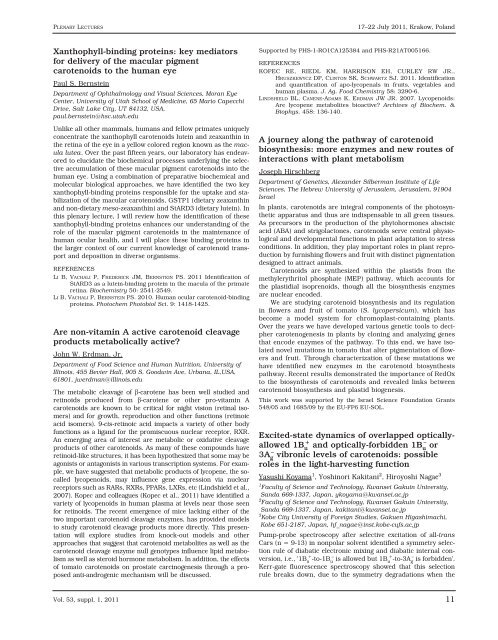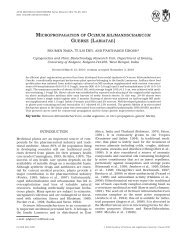ACTA BIOLOGICA CRACOVIENSIA
ACTA BIOLOGICA CRACOVIENSIA
ACTA BIOLOGICA CRACOVIENSIA
You also want an ePaper? Increase the reach of your titles
YUMPU automatically turns print PDFs into web optimized ePapers that Google loves.
PLENARY LECTURES<br />
Xanthophyll-binding proteins: key mediators<br />
for delivery of the macular pigment<br />
carotenoids to the human eye<br />
Paul S. Bernstein<br />
Department of Ophthalmology and Visual Sciences, Moran Eye<br />
Center, University of Utah School of Medicine, 65 Mario Capecchi<br />
Drive, Salt Lake City, UT 84132, USA,<br />
paul.bernstein@hsc.utah.edu<br />
Unlike all other mammals, humans and fellow primates uniquely<br />
concentrate the xanthophyll carotenoids lutein and zeaxanthin in<br />
the retina of the eye in a yellow colored region known as the macula<br />
lutea. Over the past fifteen years, our laboratory has endeavored<br />
to elucidate the biochemical processes underlying the selective<br />
accumulation of these macular pigment carotenoids into the<br />
human eye. Using a combination of preparative biochemical and<br />
molecular biological approaches, we have identified the two key<br />
xanthophyll-binding proteins responsible for the uptake and stabilization<br />
of the macular carotenoids, GSTP1 (dietary zeaxanthin<br />
and non-dietary meso-zeaxanthin) and StARD3 (dietary lutein). In<br />
this plenary lecture, I will review how the identification of these<br />
xanthophyll-binding proteins enhances our understanding of the<br />
role of the macular pigment carotenoids in the maintenance of<br />
human ocular health, and I will place these binding proteins in<br />
the larger context of our current knowledge of carotenoid transport<br />
and deposition in diverse organisms.<br />
REFERENCES<br />
LI B, VACHALI P, FREDERICK JM, BERNSTEIN PS. 2011 Identification of<br />
StARD3 as a lutein-binding protein in the macula of the primate<br />
retina. Biochemistry 50: 2541-2549.<br />
LI B, VACHALI P, BERNSTEIN PS. 2010. Human ocular carotenoid-binding<br />
proteins. Photochem Photobiol Sci. 9: 1418-1425.<br />
Are non-vitamin A active carotenoid cleavage<br />
products metabolically active?<br />
John W. Erdman, Jr.<br />
Department of Food Science and Human Nutrition, University of<br />
Illinois, 455 Bevier Hall, 905 S. Goodwin Ave, Urbana, IL,USA,<br />
61801, jwerdman@illinois.edu<br />
The metabolic cleavage of β-carotene has been well studied and<br />
retinoids produced from β-carotene or other pro-vitamin A<br />
carotenoids are known to be critical for night vision (retinal isomers)<br />
and for growth, reproduction and other functions (retinoic<br />
acid isomers). 9-cis-retinoic acid impacts a variety of other body<br />
functions as a ligand for the promiscuous nuclear receptor, RXR.<br />
An emerging area of interest are metabolic or oxidative cleavage<br />
products of other carotenoids. As many of these compounds have<br />
retinoid-like structures, it has been hypothesized that some may be<br />
agonists or antagonists in various transcription systems. For example,<br />
we have suggested that metabolic products of lycopene, the socalled<br />
lycopenoids, may influence gene expression via nuclear<br />
receptors such as RARs, RXRs, PPARs, LXRs, etc (Lindshield et al.,<br />
2007). Kopec and colleagues (Kopec et al., 2011) have identified a<br />
variety of lycopenoids in human plasma at levels near those seen<br />
for retinoids. The recent emergence of mice lacking either of the<br />
two important carotenoid cleavage enzymes, has provided models<br />
to study carotenoid cleavage products more directly. This presentation<br />
will explore studies from knock-out models and other<br />
approaches that suggest that carotenoid metabolites as well as the<br />
carotenoid cleavage enzyme null genotypes influence lipid metabolism<br />
as well as steroid hormone metabolism. In addition, the effects<br />
of tomato carotenoids on prostate carcinogenesis through a proposed<br />
anti-androgenic mechanism will be discussed.<br />
Vol. 53, suppl. 1, 2011<br />
17–22 July 2011, Krakow, Poland<br />
Supported by PHS-1-RO1CA125384 and PHS-R21AT005166.<br />
REFERENCES<br />
KOPEC RE, RIEDL KM, HARRISON EH, CURLEY RW JR.,<br />
HRUSZKEWYCZ DP, CLINTON SK, SCHWARTZ SJ. 2011. Identification<br />
and quantification of apo-lycopenals in fruits, vegetables and<br />
human plasma. J. Ag. Food Chemistry 58: 3290-6.<br />
LINDSHIELD BL, CANENE-ADAMS K, ERDMAN JW JR. 2007. Lycopenoids:<br />
Are lycopene metabolites bioactive? Archives of Biochem. &<br />
Biophys. 458: 136-140.<br />
A journey along the pathway of carotenoid<br />
biosynthesis: more enzymes and new routes of<br />
interactions with plant metabolism<br />
Joseph Hirschberg<br />
Department of Genetics, Alexander Silberman Institute of Life<br />
Sciences, The Hebrew University of Jerusalem, Jerusalem, 91904<br />
Israel<br />
In plants, carotenoids are integral components of the photosynthetic<br />
apparatus and thus are indispensable in all green tissues.<br />
As precursors in the production of the phytohormones abscisic<br />
acid (ABA) and strigolactones, carotenoids serve central physiological<br />
and developmental functions in plant adaptation to stress<br />
conditions. In addition, they play important roles in plant reproduction<br />
by furnishing flowers and fruit with distinct pigmentation<br />
designed to attract animals.<br />
Carotenoids are synthesized within the plastids from the<br />
methylerythritol phosphate (MEP) pathway, which accounts for<br />
the plastidial isoprenoids, though all the biosynthesis enzymes<br />
are nuclear encoded.<br />
We are studying carotenoid biosynthesis and its regulation<br />
in flowers and fruit of tomato (S. lycopersicum), which has<br />
become a model system for chromoplast-containing plants.<br />
Over the years we have developed various genetic tools to decipher<br />
carotenogenesis in plants by cloning and analyzing genes<br />
that encode enzymes of the pathway. To this end, we have isolated<br />
novel mutations in tomato that alter pigmentation of flowers<br />
and fruit. Through characterization of these mutations we<br />
have identified new enzymes in the carotenoid biosynthesis<br />
pathway. Recent results demonstrated the importance of RedOx<br />
to the biosynthesis of carotenoids and revealed links between<br />
carotenoid biosynthesis and plastid biogenesis.<br />
This work was supported by the Israel Science Foundation Grants<br />
548/05 and 1685/09 by the EU-FP6 EU-SOL.<br />
Excited-state dynamics of overlapped optically-<br />
+ –<br />
allowed 1Bu and optically-forbidden 1Bu or<br />
– 3Ag vibronic levels of carotenoids: possible<br />
roles in the light-harvesting function<br />
Yasushi Koyama 1 , Yoshinori Kakitani 2 , Hiroyoshi Nagae 3<br />
1Faculty of Science and Technology, Kwansei Gakuin University,<br />
Sanda 669-1337, Japan, ykoyama@kwansei.ac.jp<br />
2Faculty of Science and Technology, Kwansei Gakuin University,<br />
Sanda 669-1337, Japan, kakitani@kwansei.ac.jp<br />
3Kobe City University of Foreign Studies, Gakuen Higashimachi,<br />
Kobe 651-2187, Japan, hf_nagae@inst.kobe-cufs.ac.jp<br />
Pump-probe spectroscopy after selective excitation of all-trans<br />
Cars (n = 9-13) in nonpolar solvent identified a symmetry selection<br />
rule of diabatic electronic mixing and diabatic internal con-<br />
+ – + –<br />
version, i.e., '1Bu -to-1Bu is allowed but 1Bu -to-3Ag is forbidden'.<br />
Kerr-gate fluorescence spectroscopy showed that this selection<br />
rule breaks down, due to the symmetry degradations when the<br />
11












